keyword-social-cord
Introduction
This is a Distant Reader "study carrel", a set of structured data intended to help the student, researcher, or scholar use & understand a corpus.
This study carrel was created on 2021-05-25 by Eric Morgan <emorgan@nd.edu>. The carrel was created using the Distant Reader cord process, and the input was the result of a query applied to a local mirror of CORD, a data set of scholarly articles on the topic of COVID-19. The actual query was: keywords:social. The results of this query were saved in a cache and transformed into a set of plain text files. All of the analysis -- "reading" -- has been done against these plain text files. For example, a short narrative report has been created. This Web page is a more verbose version of that report.
All study carrels are self-contained -- no Internet connection is necessary to use them. Download this carrel for offline reading. The carrel is made up of many subdirectories and data files. The manifest describes each one in greater detail.
Size
There are 175 item(s) in this carrel, and this carrel is 831,333 words long. Each item in your study carrel is, on average, 7,105 words long. If you dig deeper, then you might want to save yourself some time by reading a shorter item. On the other hand, if your desire is for more detail, then you might consider reading a longer item. The following charts illustrate the overall size of the carrel.
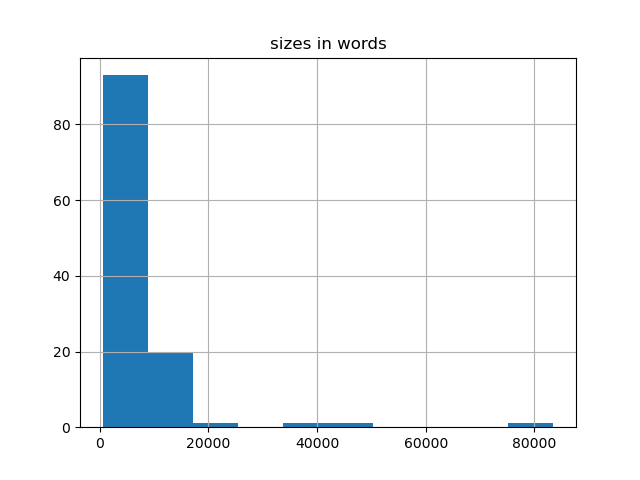
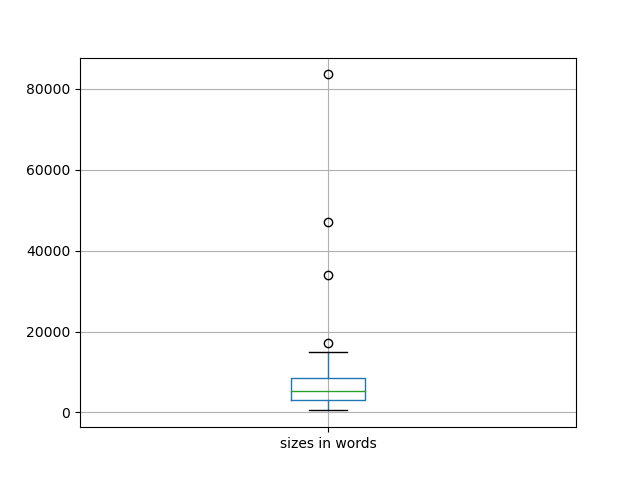
Readability
On a scale from 0 to 100, where 0 is very difficult and 100 is very easy, the documents have an average readability score of 46. Consequently, if you want to read something more simplistic, then consider a document with a higher score. If you want something more specialized, then consider something with a lower score. The following charts illustrate the overall readability of the carrel.
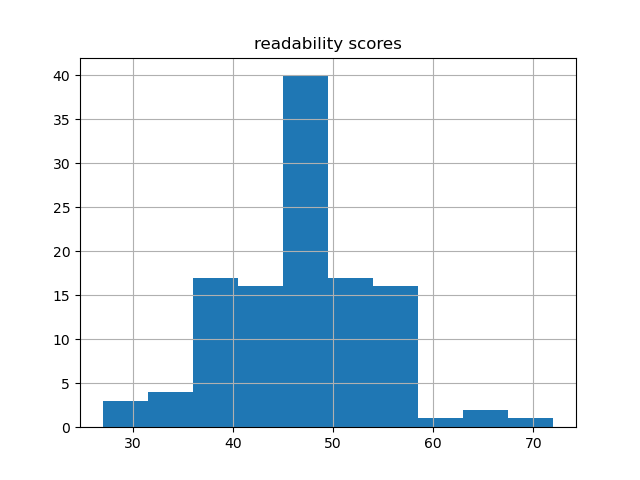
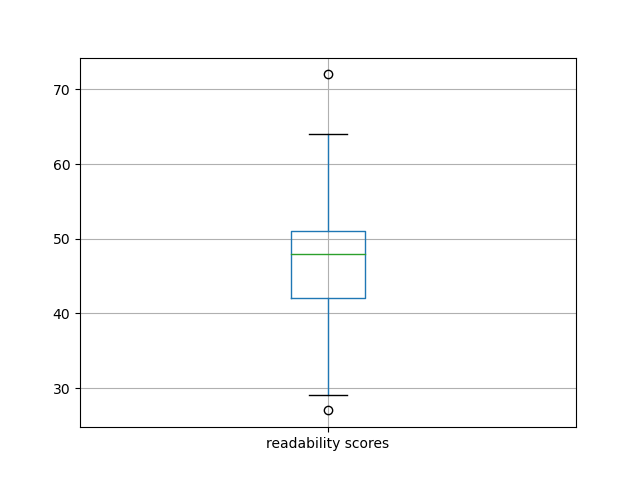
Word Frequencies
By merely counting & tabulating the frequency of individual words or phrases, you can begin to get an understanding of the carrel's "aboutness". Excluding "stop words", some of the more frequent words include:
social, health, media, also, covid, data, people, research, information, study, may, public, risk, one, use, time, based, support, distancing, well, care, i, new, community, pandemic, will, work, model, human, many, used, life, analysis, individuals, using, disease, mental, different, among, population, online, studies, self, effects, related, systems, age, however, two, individual
Using the three most frequent words, the three files containing all of those words the most are Section II: Poster Sessions, Expanding the Concept of Public Health, and The Neurobiology of Social Distance.
The most frequent two-word phrases (bigrams) include:
social media, social distancing, public health, mental health, social support, health care, social isolation, older adults, social networks, social capital, social network, media use, united states, social work, machine learning, fake news, media platforms, social workers, social determinants, cord uid, doc id, young people, older people, social relations, hong kong, risk perception, social interactions, health services, health promotion, climate change, physical activity, copyright holder, systematic review, made available, risk factors, author funder, granted medrxiv, infectious diseases, infectious disease, international license, online social, version posted, world health, perceived social, developing countries, family members, physical health, life satisfaction, social relationships, health outcomes
And the three file that use all of the three most frequent phrases are Misinformation sharing and social media fatigue during COVID-19: An affordance and cognitive load perspective Social distancing across vulnerability, race, politics, and employment: How different Americans changed behaviors before and after major COVID-19 policy announcements, and Loops, ladders and links: the recursivity of social and machine learning.
While often deemed superficial or sophomoric, rudimentary frequencies and their associated "word clouds" can be quite insightful:
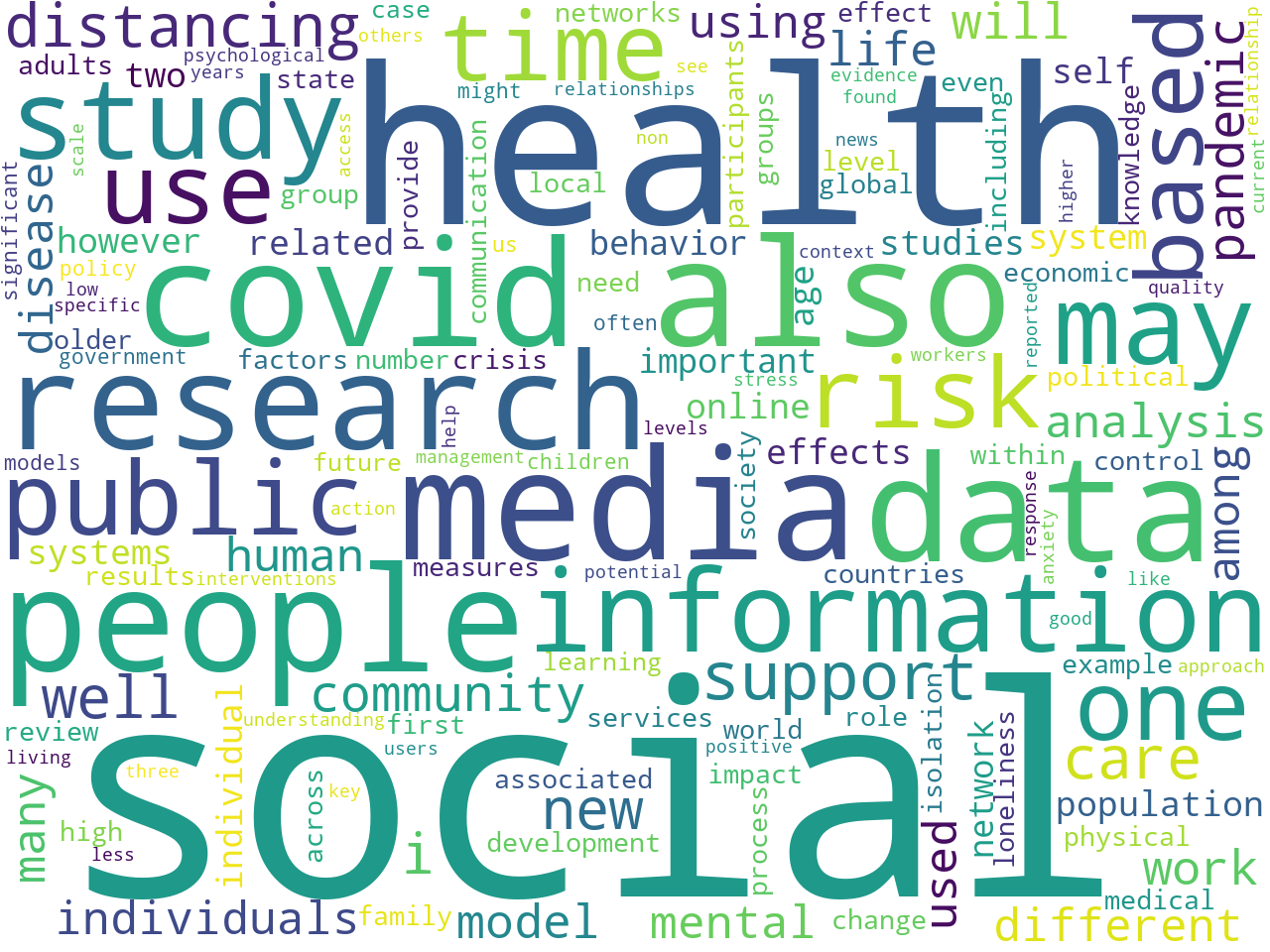
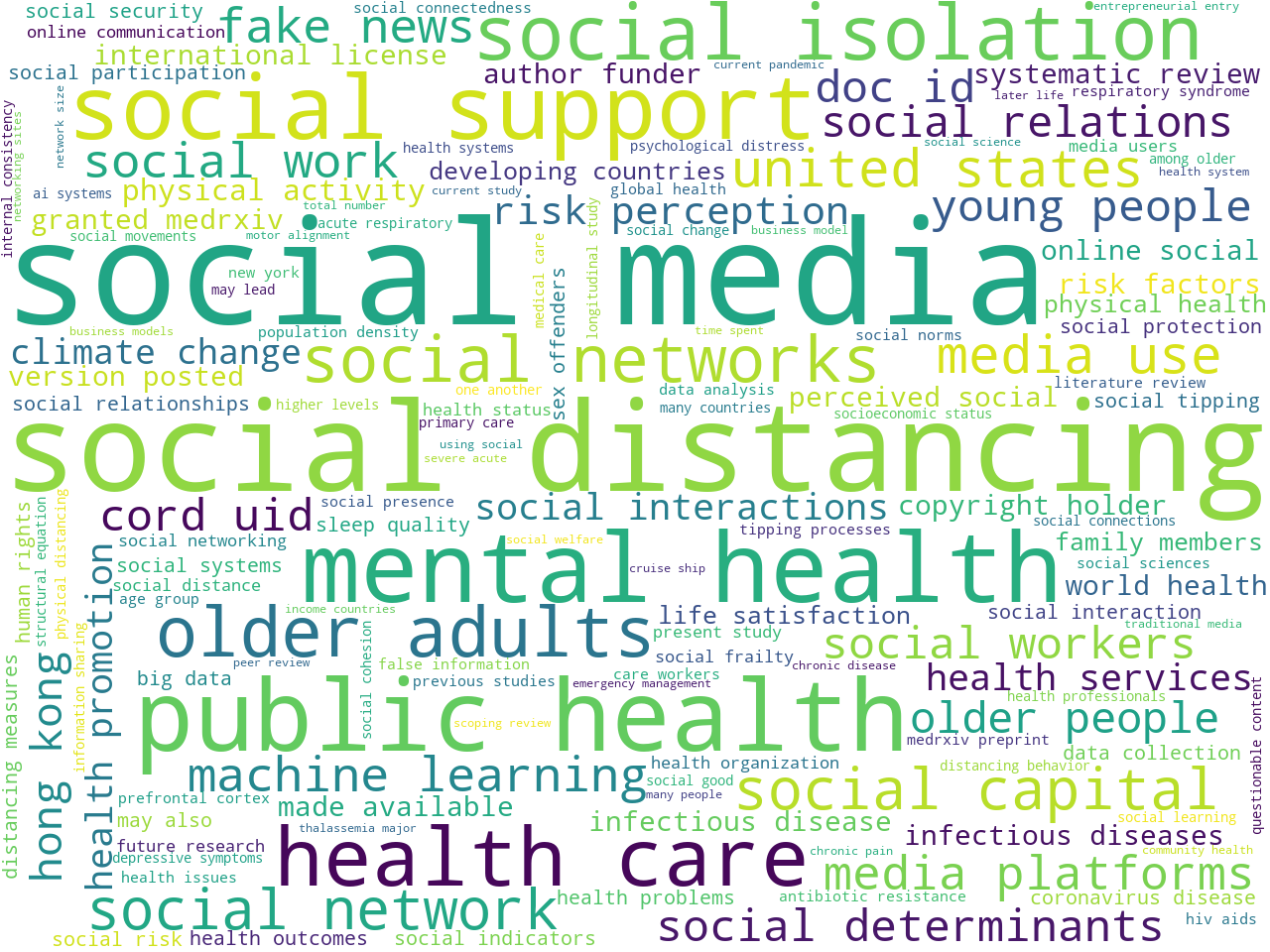
Keywords
Sets of keywords -- statistically significant words -- can be enumerated by comparing the relative frequency of words with the number of times the words appear in an entire corpus. Some of the most statistically significant keywords in the carrel include:
social, covid-19, medium, health, datum, twitter, system, people, old, network, model, human, distancing, work, loneliness, information, facebook, country, china, united, support, study, risk, research, political, pandemic, new, child, care, agent, age, worker, usa, states, self, scale, public, problem, mental, knowledge, internet, international, individual, hiv, government, crisis, community, action, urban, u.s.
And now word clouds really begin to shine:

Topic Modeling
Topic modeling is another popular approach to connoting the aboutness of a corpus. If the study carrel could be summed up in a single word, then that word might be social, and Artificial Intelligence Technology and Social Problem Solving is most about that word.
If the study carrel could be summed up in three words ("topics") then those words and their significantly associated titles include:
- social - The State of AI Ethics Report (June 2020)
- social - Social Relationships and Adaptation in Later Life
- health - Sociality, Parasites, and Pathogens in Bats
If the study carrel could be summed up in five topics, and each topic were each denoted with three words, then those topics and their most significantly associated files would be:
- social, data, information - Social big data: Recent achievements and new challenges
- social, health, covid - Developmental trajectory of interpersonal motor alignment: positive social effects and link to social cognition
- health, social, public - Expanding the Concept of Public Health
- social, media, people - The Role of Entrepreneurs in Advancing Sustainable Lifestyles: Challenges, Impacts, and Future Opportunities
- health, care, social - Section II: Poster Sessions
Moreover, the totality of the study carrel's aboutness, can be visualized with the following pie chart:
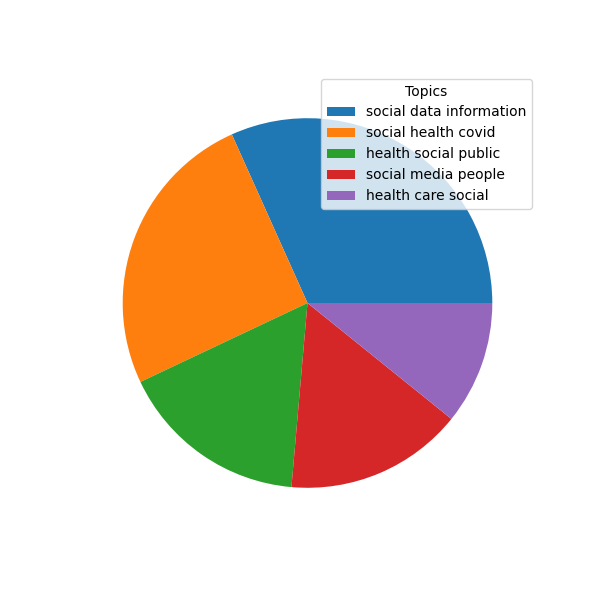
Noun & Verbs
Through an analysis of your study carrel's parts-of-speech, you are able to answer question beyonds aboutness. For example, a list of the most frequent nouns helps you answer what questions; "What is discussed in this collection?":
health, media, people, data, information, research, study, risk, time, care, community, pandemic, support, use, individuals, distancing, model, life, analysis, population, work, effects, studies, self, disease, systems, system, age, behavior, participants, level, network, number, group, factors, groups, development, role, example, countries, services, results, impact, process, effect, networks, measures, adults, knowledge, isolation
An enumeration of the verbs helps you learn what actions take place in a text or what the things in the text do. Very frequently, the most common lemmatized verbs are "be", "have", and "do"; the more interesting verbs usually occur further down the list of frequencies:
used, including, based, provide, making, show, increased, related, developed, see, take, reporting, given, found, needed, reduces, leading, associated, identified, helped, following, considering, understand, suggest, becoming, lived, created, working, affect, sharing, support, required, address, improving, focuses, compare, knowing, examine, allowed, perceived, existing, change, involve, promote, indicate, learning, regarding, present, build, influence
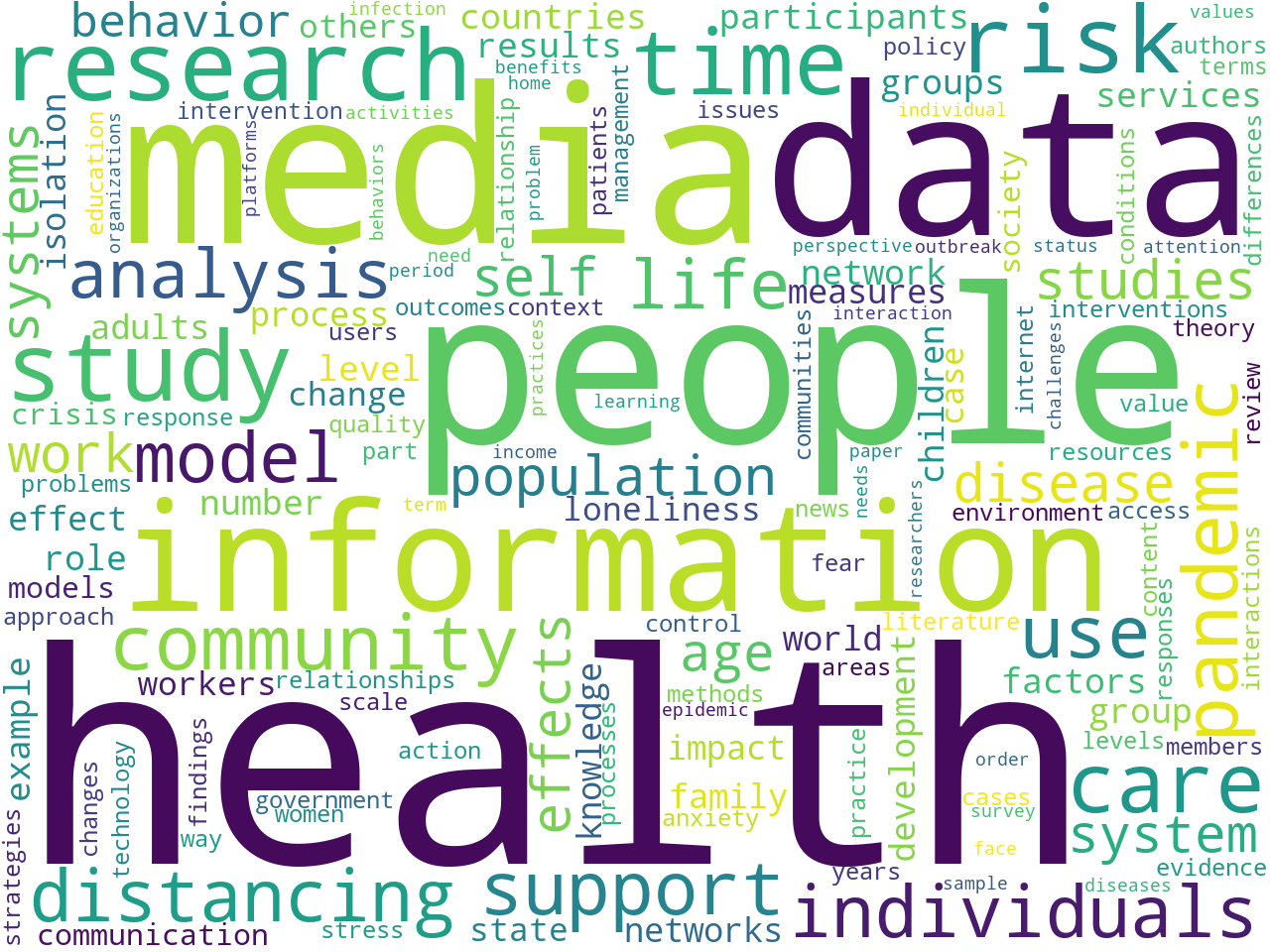
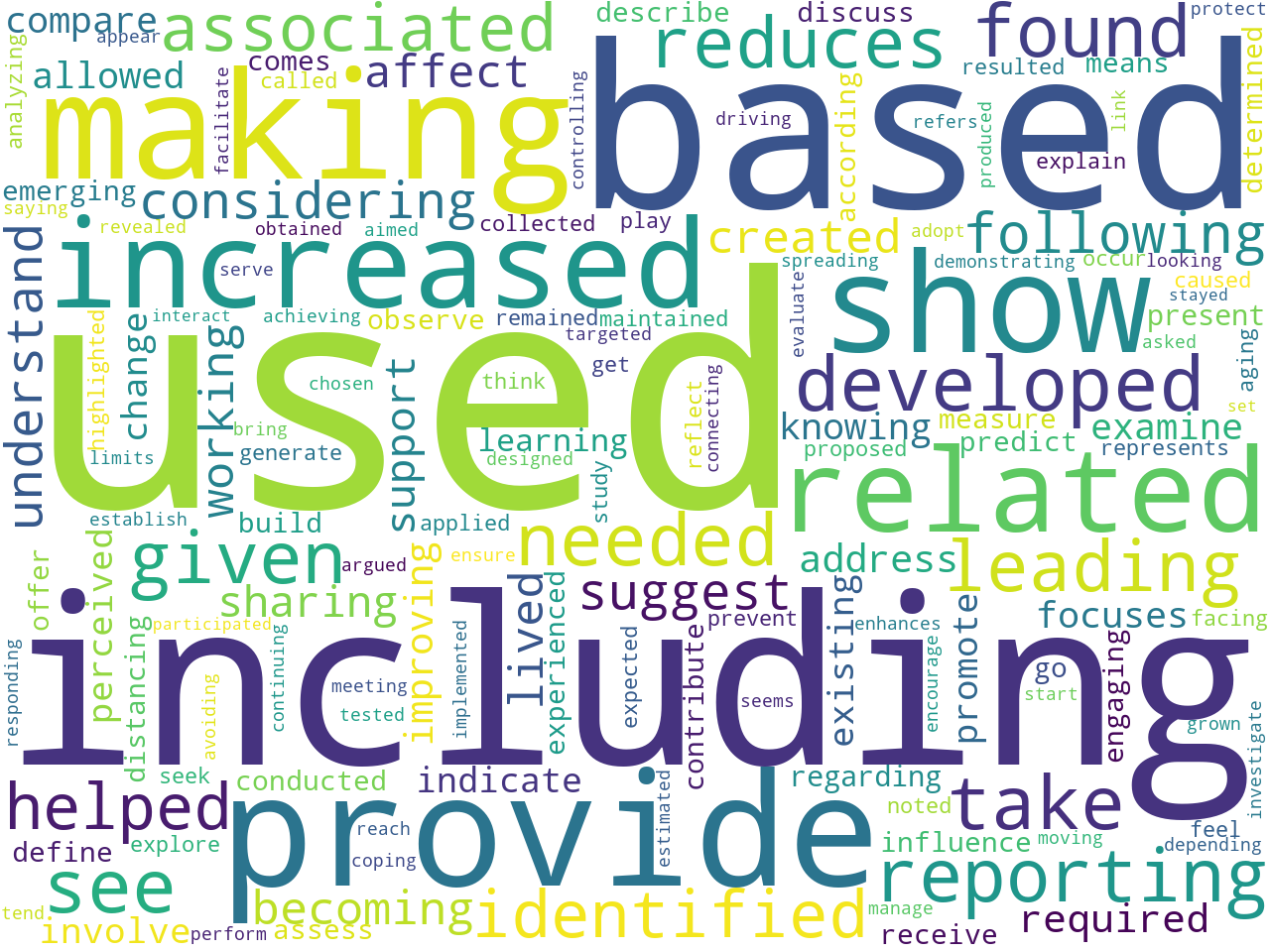
Proper Nouns
An extraction of proper nouns helps you determine the names of people and places in your study carrel.
COVID-19, Social, Health, China, •, United, Twitter, HIV, AI, SARS, Facebook, States, US, New, World, Public, Table, Fig, March, Research, Canada, Hong, U.S., UK, Kong, National, Spinoza, USA, India, AR, Coronavirus, sha, MERS, Community, AIDS, May, April, Africa, Europe, University, Organization, International, CC, social, DOI, der, Media, CoV-2, Disease, South
An analysis of personal pronouns enables you to answer at least two questions: 1) "What, if any, is the overall gender of my study carrel?", and 2) "To what degree are the texts in my study carrel self-centered versus inclusive?"
we, it, their, they, our, its, them, i, us, you, one, themselves, his, he, her, my, she, your, itself, me, ourselves, him, oneself, herself, himself, yourself, 's, myself, s, em, whose, thy, thine, thee, mg, j"'"1tllu, heals, cord-325396-ot7pvexv, cl=, broader, -itself, -3.3411
Below are words cloud of your study carrel's proper & personal pronouns.
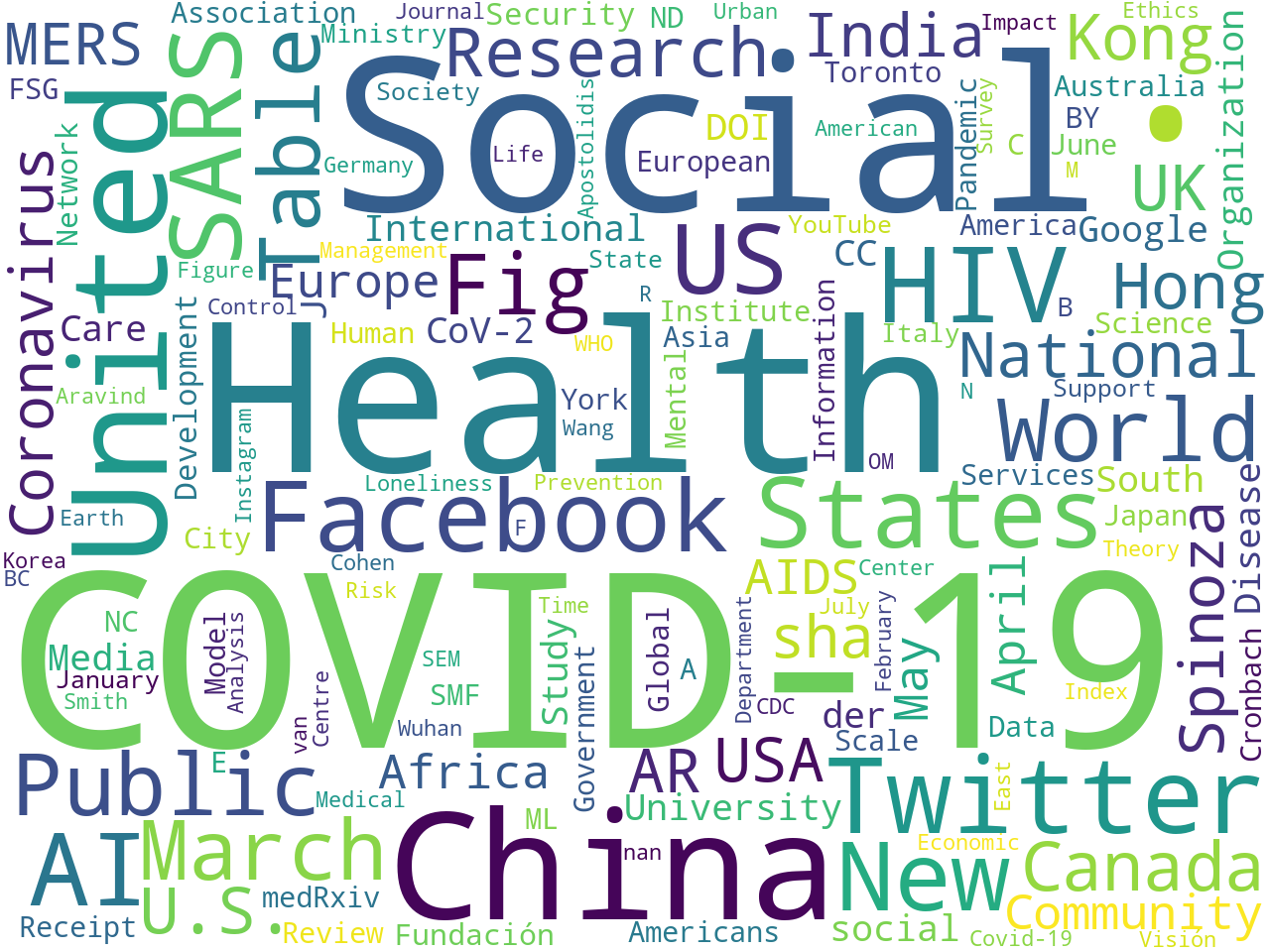

Adjectives & Verbs
Learning about a corpus's adjectives and adverbs helps you answer how questions: "How are things described and how are things done?" An analysis of adjectives and adverbs also points to a corpus's overall sentiment. "In general, is my study carrel positive or negative?"
social, public, new, many, different, mental, human, important, older, physical, online, political, economic, high, local, individual, significant, positive, medical, higher, specific, global, psychological, current, non, low, large, key, negative, personal, first, available, emotional, future, covid-19, possible, urban, critical, various, cognitive, potential, likely, particular, effective, common, environmental, greater, digital, early, national
also, well, however, even, often, therefore, especially, rather, still, less, particularly, significantly, first, just, now, together, n't, socially, finally, already, moreover, much, specifically, far, directly, highly, furthermore, potentially, instead, always, yet, similarly, online, currently, indeed, recently, hence, generally, increasingly, better, alone, strongly, never, relatively, away, additionally, almost, later, effectively, previously
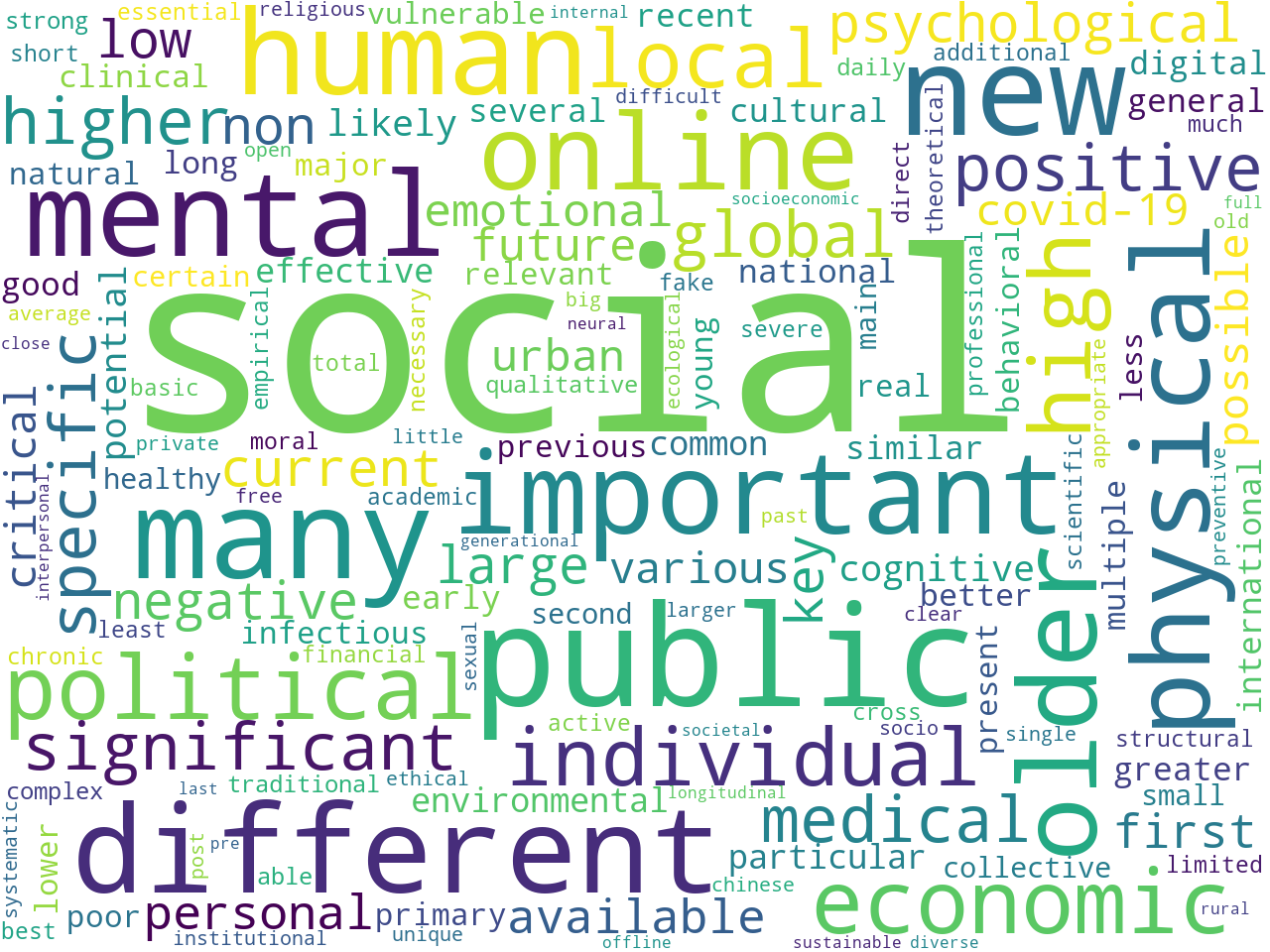
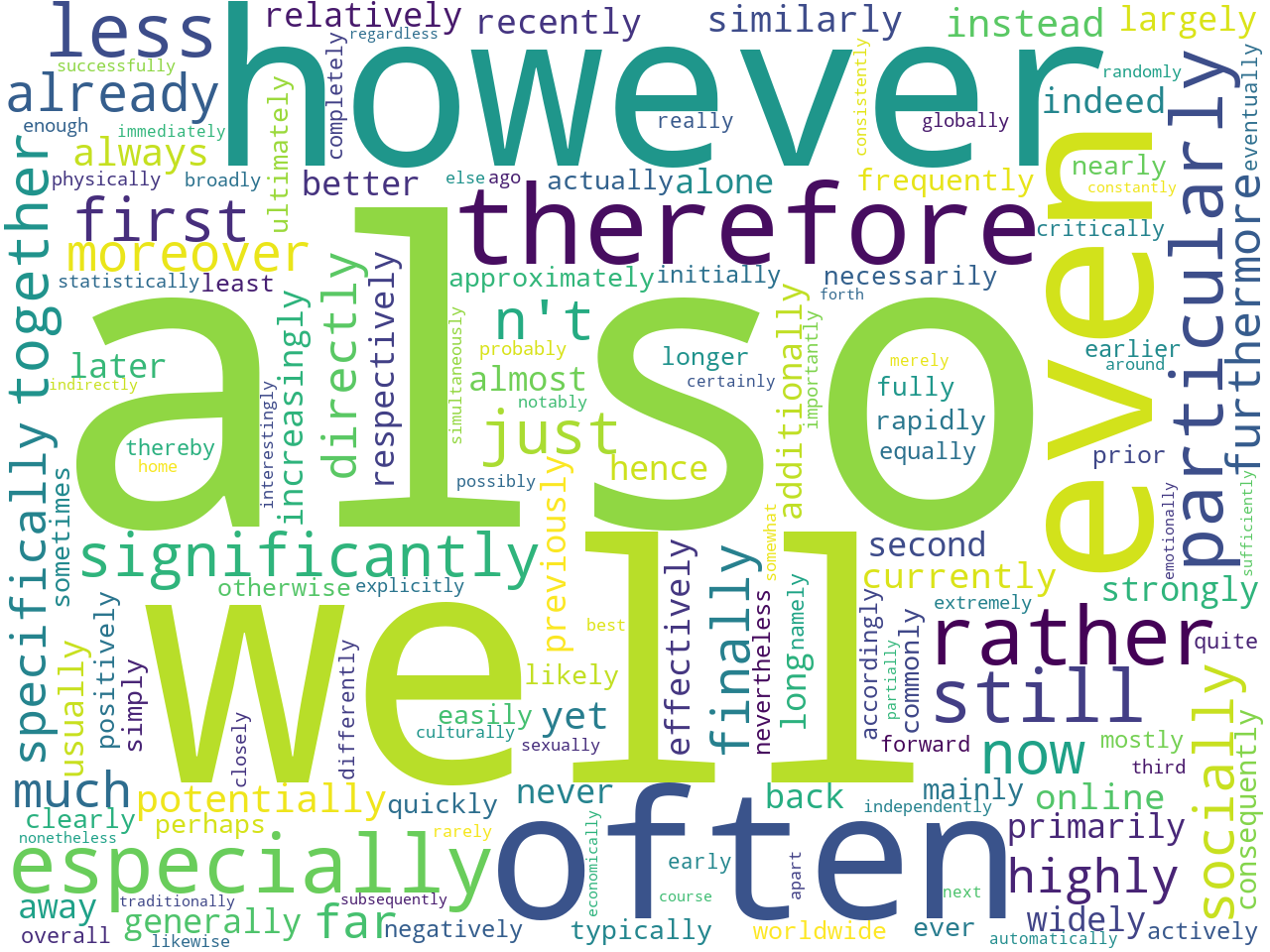
Next steps
There is much more to a study carrel than the things outlined above. Use this page's menubar to navigate and explore in more detail. There you will find additional features & functions including: ngrams, parts-of-speech, grammars, named entities, topic modeling, a simple search interface, etc.
Again, study carrels are self-contained. Download this carrel for offline viewing and use.
Thank you for using the Distant Reader.